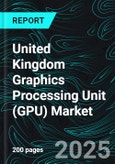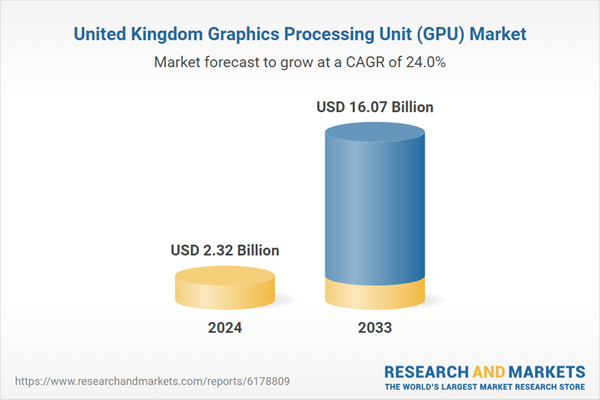United Kingdom Graphics Processing Unit (GPU) Industry Overview
A specialized processor called a Graphics Processing Unit (GPU) is made to perform intricate calculations, especially when it comes to producing simulations, movies, and graphics. GPUs, which were first developed for multimedia and gaming, are today essential components of high-performance computing, machine learning, artificial intelligence, and data analytics. GPUs carry out parallel operations in contrast to Central Processing Units (CPUs), which handle jobs sequentially. This allows for faster processing of complex algorithms and massive datasets. They are extensively utilized in sectors like entertainment, healthcare, banking, and automobiles. Because of their speed, economy, and scalability, GPUs are now essential for innovation, supporting both enterprise-level computational requirements and consumer experiences.The growing demand in the gaming, AI, and cloud computing industries is driving the growth of the GPU market in the UK. GPU adoption among consumers is fueled by a robust gaming culture that is fueled by immersive technologies and esports. In parallel, GPUs are used in sectors like banking, healthcare, and automotive for simulations, machine learning, and predictive analytics. Furthermore, the flourishing media, film, and animation sectors in the UK require top-notch graphics processing. Government programs promoting supercomputing, AI research, and digital transformation also encourage GPU adoption in businesses and academic institutions. GPUs are essential for enabling performance, scalability, and sophisticated data-driven applications as innovation picks up speed.
Growth Drivers for the United Kingdom Graphics Processing Unit (GPU) Market
Gaming and Esports Expansion
With millions of gamers and a flourishing developer community, the UK's booming gaming and esports sector is a major driver of GPU demand. High-definition graphics, real-time rendering, and immersive virtual reality (VR) and augmented reality (AR) experiences are all made possible by sophisticated GPUs. Powerful GPUs are necessary for competitive gaming and live-streaming in esports, which is becoming more and more popular nationwide. GPU-powered servers are also necessary for cloud gaming services to provide lag-free gameplay. The need for GPUs keeps growing as gaming culture becomes more established and esports become more well-known, making this industry a major contributor to the UK GPU market.Artificial Intelligence and Machine Learning
From healthcare to finance, artificial intelligence (AI) and machine learning (ML) are quickly changing a variety of industries in the UK. GPUs are essential to this change because they speed up data processing, deep learning, and predictive analytics. GPUs are crucial for training and executing sophisticated algorithms because they can conduct parallel computations more efficiently than CPUs. While healthcare uses GPUs for medical imaging and diagnostics, UK financial institutions utilize GPU-powered AI for risk analysis and fraud detection. AI is used in the automotive sector to study driverless cars and intelligent mobility solutions. The demand for GPUs will rise sharply as AI investments from the UK government and business sector increase.High-Performance Computing (HPC)
Another significant factor driving the need for GPUs in the UK is High-Performance Computing (HPC). GPU-powered supercomputers are essential for advanced simulations, genetic research, and climate modeling in universities, research institutions, and government-funded labs. Because of their superior parallel processing capabilities, GPUs are perfect for managing large datasets and scientific tasks. The UK is more dependent on GPU-based HPC infrastructure as a result of its dedication to innovation, especially in fields like space exploration, medicines, and renewable energy. Furthermore, cloud service providers are expanding access for businesses and academia by scaling GPU clusters to offer HPC-as-a-service. The increasing use of GPUs in HPC confirms their significance in promoting economic and scientific innovation in the UK.Challenges in the United Kingdom Graphics Processing Unit (GPU) Market
High Costs
For the UK GPU market, high prices continue to be a major obstacle. Advanced GPUs are necessary for high-performance computing, gaming, and artificial intelligence, but they are sometimes expensive, making them inaccessible to entrepreneurs, consumers, and educational institutions. The problem is made worse by elements like import taxes, growing production costs, and worldwide shortages of semiconductors. Expensive prices can hinder market penetration for smaller enterprises and slow acceptance in developing industries. Even when performance improvements are justified by technology breakthroughs, many potential users are still forced to postpone upgrades or choose less powerful options, which can impede the general expansion and democratization of GPU applications in the UK.Cryptocurrency Volatility
The instability of the cryptocurrency market has an impact on the UK GPU market as well, leading to erratic demand patterns. Miners buy a lot of GPUs during cryptocurrency booms, which causes shortages and drives up costs, frequently at the expense of researchers, businesses, and gamers. On the other hand, surplus inventory can lower GPU sales and throw off manufacturers' and retailers' income projections when cryptocurrency values decline. Supply chain management and production planning are made more difficult by this cyclical demand. Uncertainty is further increased by growing governmental scrutiny and environmental issues related to cryptocurrency mining. Consequently, the UK GPU market becomes unstable and risky due to its dependence on cryptocurrency-driven GPU demand.London Graphics Processing Unit (GPU) Market
London is a major hub for the UK GPU market, driven by its concentration of fintech, media, and technology companies. Financial institutions use GPUs for high-speed trading, predictive analytics, and risk modeling, while media and creative industries leverage them for animation, VFX, and video production. Startups and AI-focused enterprises in London also adopt GPUs for machine learning, data analytics, and cloud computing applications. High consumer demand for gaming further strengthens the market. However, high operating costs, energy expenses, and space constraints challenge large-scale deployments. London remains a strategic region for innovation, research, and commercial GPU adoption.North West United Kingdom Graphics Processing Unit (GPU) Market
The North West of the UK, including cities like Manchester and Liverpool, has a growing GPU market supported by technology, research, and higher education institutions. Universities utilize GPUs for scientific research, AI development, and simulations, driving academic demand. The region’s gaming community and local tech startups further contribute to consumer and enterprise GPU adoption. North West’s industrial and digital sector expansion enhances opportunities for HPC and AI applications. While energy costs and supply chain dependencies pose challenges, investments in digital infrastructure and data centers make the region increasingly important for GPU-driven computing solutions and emerging technology projects.Scotland Graphics Processing Unit (GPU) Market
Scotland’s GPU market is expanding, fueled by universities, research centers, and industries leveraging high-performance computing (HPC) and AI. Academic and scientific research, particularly in life sciences, climate modeling, and engineering simulations, drives GPU demand. The country’s growing technology sector, including startups in AI and gaming, further strengthens adoption. Scotland’s government initiatives supporting digital innovation and AI research encourage GPU deployment across enterprises and institutions. However, energy costs, geographic distribution of facilities, and limited local manufacturing capacity pose operational challenges. Despite these hurdles, Scotland’s combination of academic excellence, innovation initiatives, and growing digital infrastructure positions it as a key UK GPU market region.West Midlands Graphics Processing Unit (GPU) Market
The West Midlands, encompassing Birmingham and Coventry, is an emerging GPU market hub in the UK. The region’s automotive, manufacturing, and engineering sectors increasingly leverage GPUs for simulations, autonomous vehicle research, and AI applications. Universities and research institutions drive demand through HPC, scientific computing, and AI development projects. The growing tech startup ecosystem and gaming communities further support GPU adoption for both professional and consumer use. While challenges include high energy costs and limited local production, infrastructure investments and government digital initiatives strengthen the region’s GPU ecosystem. West Midlands is becoming a strategic area for enterprise, academic, and industrial GPU deployment.Recent Developments in United Kingdom Graphics Processing Unit (GPU) Market
- In September 2025, Nvidia announced the UK will have Europe’s largest GPU cluster, totaling 120,000 Blackwell GPUs by the end of 2026, in a major boost for the country’s sovereign compute capacity.
United Kingdom Graphics Processing Unit (GPU) Market Segments:
Component
- Hardware
- Software
- Services
Type
- Integrated GPU
- Discrete GPU
- Hybrid GPU
Deployment
- On-Premise
- Cloud
Application
- IT & Telecommunication
- Healthcare
- Media & Entertainment
- Others
Region
- London
- South East
- North West
- East of England
- South West
- Scotland
- West Midlands
- Yorkshire and the Humber
- East Midlands
- Others
All companies have been covered from 5 viewpoints:
- Company Overview
- Key Persons
- Recent Development & Strategies
- SWOT Analysis
- Sales Analysis
Key Players Analysis
- Intel Corporation
- Advanced Micro Devices Inc.
- Nvidia Corporation
- Imagination Technologies Group
- Samsung Electronics Co. Ltd
- Arm Limited (Soft Bank Group)
- EVGA Corporation
- SAPPHIRE Technology Limited
- Qualcomm Technologies Inc.
Table of Contents
Companies Mentioned
- Intel Corporation
- Advanced Micro Devices Inc.
- Nvidia Corporation
- Imagination Technologies Group
- Samsung Electronics Co. Ltd
- Arm Limited (Soft Bank Group)
- EVGA Corporation
- SAPPHIRE Technology Limited
- Qualcomm Technologies Inc.
Methodology
In this report, for analyzing the future trends for the studied market during the forecast period, the publisher has incorporated rigorous statistical and econometric methods, further scrutinized by secondary, primary sources and by in-house experts, supported through their extensive data intelligence repository. The market is studied holistically from both demand and supply-side perspectives. This is carried out to analyze both end-user and producer behavior patterns, in the review period, which affects price, demand and consumption trends. As the study demands to analyze the long-term nature of the market, the identification of factors influencing the market is based on the fundamentality of the study market.
Through secondary and primary researches, which largely include interviews with industry participants, reliable statistics, and regional intelligence, are identified and are transformed to quantitative data through data extraction, and further applied for inferential purposes. The publisher's in-house industry experts play an instrumental role in designing analytic tools and models, tailored to the requirements of a particular industry segment. These analytical tools and models sanitize the data & statistics and enhance the accuracy of their recommendations and advice.
Primary Research
The primary purpose of this phase is to extract qualitative information regarding the market from the key industry leaders. The primary research efforts include reaching out to participants through mail, tele-conversations, referrals, professional networks, and face-to-face interactions. The publisher also established professional corporate relations with various companies that allow us greater flexibility for reaching out to industry participants and commentators for interviews and discussions, fulfilling the following functions:
- Validates and improves the data quality and strengthens research proceeds
- Further develop the analyst team’s market understanding and expertise
- Supplies authentic information about market size, share, growth, and forecast
The researcher's primary research interview and discussion panels are typically composed of the most experienced industry members. These participants include, however, are not limited to:
- Chief executives and VPs of leading corporations specific to the industry
- Product and sales managers or country heads; channel partners and top level distributors; banking, investment, and valuation experts
- Key opinion leaders (KOLs)
Secondary Research
The publisher refers to a broad array of industry sources for their secondary research, which typically includes, however, is not limited to:
- Company SEC filings, annual reports, company websites, broker & financial reports, and investor presentations for competitive scenario and shape of the industry
- Patent and regulatory databases for understanding of technical & legal developments
- Scientific and technical writings for product information and related preemptions
- Regional government and statistical databases for macro analysis
- Authentic new articles, webcasts, and other related releases for market evaluation
- Internal and external proprietary databases, key market indicators, and relevant press releases for market estimates and forecasts

LOADING...
Table Information
| Report Attribute | Details |
|---|---|
| No. of Pages | 200 |
| Published | September 2025 |
| Forecast Period | 2024 - 2033 |
| Estimated Market Value ( USD | $ 2.32 Billion |
| Forecasted Market Value ( USD | $ 16.07 Billion |
| Compound Annual Growth Rate | 23.9% |
| Regions Covered | United Kingdom |
| No. of Companies Mentioned | 9 |









